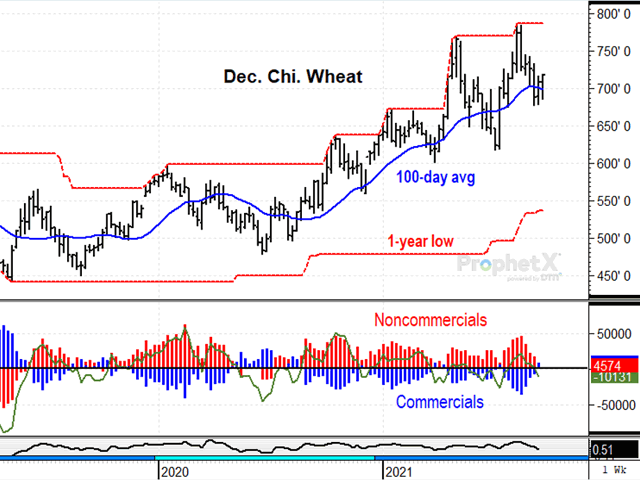Todd's Take
Chicago Wheat Has Unusually Firm Support
You may have noticed DTN's market coverage normally doesn't have a lot to say about Chicago wheat -- the contract representing the soft red winter (SRW) variety. I've always found it amusing, for example, that December Chicago wheat has 50% more open interest than December KC wheat, even though SRW wheat accounted for 22% of this year's production and hard red winter (HRW) wheat accounted for 46% of this year's production.
Like a lot of things in the world of marketing, popularity often trumps substance, and the popularity of Chicago wheat among futures traders is a testament to the power of Chicago's brand, even in this day of electronic trading.
Ironically, my interest in Chicago wheat lately has been because it has not been very popular with traders recently. I find that intriguing given this wheat's bullish fundamentals. Soft red winter wheat is a lower protein variety, good for making cookies, cakes and crackers. One thing we noticed in early 2020, when SRW wheat supplies first became tighter than normal, was that end users are not shy about paying up for SRW wheat when needed -- it is not easily replaced in those popular consumer goods.
U.S. supplies of SRW wheat first tightened in 2019-20 when excessive rain in the eastern Midwest sent ending stocks to 105 million bushels (mb), the lowest in 12 years. Spot Chicago wheat peaked just shy of $6.00 during that winter season and, at times, specific cash SRW prices were bid well above the board.
In 2020-21, the SRW wheat crop increased 11% to 266 mb but was not enough to satisfy 291 mb of demand. Spot Chicago wheat hit a high of $7.73 per bushel in April 2021 as ending SRW wheat stocks headed to a 13-year low of 85 mb.
In the new season that began June 1, 2021, the SRW wheat crop increased a whopping 38% to 366 mb. USDA expects demand to increase 23% to 357 mb, a tall order for the remaining eight months of the season. If USDA's demand estimate holds up, 99 mb of ending stocks in 2021-22 will be a third consecutive year of tight SRW supplies.
P[L1] D[0x0] M[300x250] OOP[F] ADUNIT[] T[]
It is still early in the new season to have much confidence in any demand estimate for SRW wheat; but there are other market clues to consider. One strong factor in favor of higher wheat prices in general is USDA's estimate that ending wheat stocks among the world's top eight exporters will total 1.95 billion bushels (bb), the lowest in eight years.
As of Thursday, Sept. 23, December Chicago wheat settled at $7.17 3/4, near some of the highest spot prices Chicago wheat has traded in eight years.
One might think with prices above $7.00, the long side of the market would be heavy with speculators, but that is not the case. Friday's CFTC data showed noncommercial net longs at 4,574 as of Sept. 14, a slight position in historical terms. The other abnormal thing for prices this high is to see commercials net long 8,069 contracts, an interesting sign of end-user support.
A closer look shows commercials turned net long in Chicago wheat four times in 2021, each one coinciding with December prices falling below the 100-day average. This seems to be a classic case of end users buying on dips and the support has been firm enough each time to eventually turn prices back above their 100-day averages.
I first mentioned this in a DTN closing market video on April 5 and again this week, on Tuesday, Sept. 21. I didn't expect prices to turn higher so quickly, but December Chicago wheat was back above its 100-day average of $7.02 the very next day and climbed higher, to $7.17 3/4 on Thursday.
I mention this because it is one thing for USDA to make a demand estimate, which may or may not be accurate. To have commercials actively supporting prices at these higher levels is an extra layer of credibility not often seen.
At this time of year, when the days are getting shorter and northern wheat production estimates are settling down, demand remains the unknown part of the price equation. Barring a big surprise, a third year of tight supplies should keep spot Chicago wheat prices well supported into early 2022. It will be interesting to see if prices can top the 2021 high of $7.74 3/4.
Join us at this year's DTN Ag Summit in Chicago on Dec. 5 to 7, our annual event with several learning opportunities to choose from. Find out more and register at www.dtn.com/dtn-ag-summit/.
**
Comments above are for educational purposes only and are not meant as specific trade recommendations. The buying and selling of grain or grain futures or options involve substantial risk and are not suitable for everyone.
Todd Hultman can be reached at Todd.Hultman@dtn.com
Follow him on Twitter @ToddHultman1
(c) Copyright 2021 DTN, LLC. All rights reserved.




